Each of the states has designated a number of symbols to represent its history and values. Here’s information about each of the State flags.
Alabama: 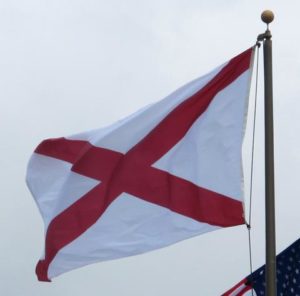 “The flag of the state of Alabama shall be a crimson cross of St. Andrew on a field of white. The bars forming the cross shall be not less than six inches broad, and must extend diagonally across the flag from side to side.” Adopted in 1895.
“The flag of the state of Alabama shall be a crimson cross of St. Andrew on a field of white. The bars forming the cross shall be not less than six inches broad, and must extend diagonally across the flag from side to side.” Adopted in 1895.
Alaska:  Alaska’s state flag features eight gold stars, forming the Big Dipper (Ursa Major or “Great Bear” constellation) and Polaris, on a dark blue field. The Big Dipper is a symbol of strength, and Polaris (the North Star ) is a symbol of Alaska’s northern location and “the ever constant star for the mariner, the explorer, hunter, trapper, prospector, woodsman, and the surveyor…” (quote from legislation). The blue background represents the sky, sea, lakes, and wildflowers of Alaska (the official state flower, the forget-me-not, is also blue).
Alaska’s state flag features eight gold stars, forming the Big Dipper (Ursa Major or “Great Bear” constellation) and Polaris, on a dark blue field. The Big Dipper is a symbol of strength, and Polaris (the North Star ) is a symbol of Alaska’s northern location and “the ever constant star for the mariner, the explorer, hunter, trapper, prospector, woodsman, and the surveyor…” (quote from legislation). The blue background represents the sky, sea, lakes, and wildflowers of Alaska (the official state flower, the forget-me-not, is also blue).
Arizona: 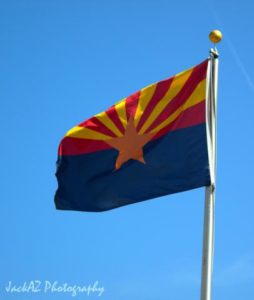 The state flag of Arizona “represents the copper star of Arizona rising from a blue field in the face of a setting sun” (quote from legislation).
The state flag of Arizona “represents the copper star of Arizona rising from a blue field in the face of a setting sun” (quote from legislation).
In 1911 a rifle team from the Arizona Territory was scheduled for a competition match in Ohio and needed a flag to represent their team. Charles Harris (the Adjutant General of the territory) quickly designed what was to become the Arizona state flag (Arizona was admitted to the Union in 1912 – this flag became the official flag of Arizona in 1917).
The 13 gold and red “beams” or “rays” on Arizona’s flag represent the sun setting over the western desert and the original 13 colonies (red and gold colors were also carried by Coronado’s Spanish expedition in search of the Seven Cities of Cibola in 1540).
The center star signifies copper production (Arizona produces more copper than any other state in the country). The field of blue is the same “liberty blue” as the United States flag. Blue and “old gold” are also Arizona’s official state colors. The flag was adopted on February 17, 1917
Arkansas: 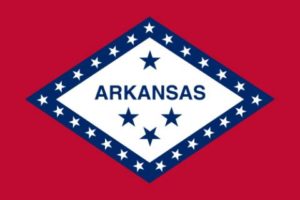 The state flag of Arkansas is red, white, and blue to signify that Arkansas is one of the United States. The flag of Arkansas consists of a red field charged with a large blue-bordered white lozenge (or diamond). The large diamond represents the only diamond producing state in the USA.
The state flag of Arkansas is red, white, and blue to signify that Arkansas is one of the United States. The flag of Arkansas consists of a red field charged with a large blue-bordered white lozenge (or diamond). The large diamond represents the only diamond producing state in the USA.
Twenty-five small white stars placed within the blue border show that Arkansas was the 25th state to join the Union.
The inscription “ARKANSAS” appears in blue within the white lozenge, with one star above (representing the Confederacy) and three stars below symbolizing the three nations which ruled Arkansas before it became a state (Spain, France, and the United States), also that Arkansas was the third state created out of the Louisiana Purchase. The star above and the two outer stars below point upwards; the inner star below points downwards.
California: 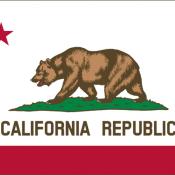 The 1911 statute stated: The bear flag is hereby selected and adopted as the state flag of California. … The said bear flag shall consist of a flag of a length equal to one and one-half the width thereof; the upper five-sixths of the width thereof to be a white field, and the lower sixth of the width thereof to be a red stripe; there shall appear in the white field in the upper left-hand corner a single red star, and at the bottom of the white field the words ‘California Republic,’ and in the center of the white field a California grizzly bear upon a grass plat, in the position of walking toward the left of the said field; said bear shall be dark brown in color and in length, equal to one-third of the length of said flag.
The 1911 statute stated: The bear flag is hereby selected and adopted as the state flag of California. … The said bear flag shall consist of a flag of a length equal to one and one-half the width thereof; the upper five-sixths of the width thereof to be a white field, and the lower sixth of the width thereof to be a red stripe; there shall appear in the white field in the upper left-hand corner a single red star, and at the bottom of the white field the words ‘California Republic,’ and in the center of the white field a California grizzly bear upon a grass plat, in the position of walking toward the left of the said field; said bear shall be dark brown in color and in length, equal to one-third of the length of said flag.
Colorado: 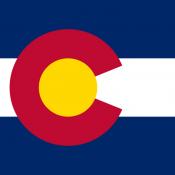 The flag of the state of Colorado is a bicolor horizontal triband of blue and white charged with a circular red letter “C” filled with a golden disk. That is, it consists of three horizontal stripes of equal width, the top and bottom stripes blue, and the middle stripe white, on top of which sits a circular red “C”, filled with a golden disk. The blue is meant to represent the skies, the gold stands for the abundant sunshine the state enjoys, the white represents the snowcapped mountains, and the red represents the ruddy earth. Adopted on March 31, 1964.
The flag of the state of Colorado is a bicolor horizontal triband of blue and white charged with a circular red letter “C” filled with a golden disk. That is, it consists of three horizontal stripes of equal width, the top and bottom stripes blue, and the middle stripe white, on top of which sits a circular red “C”, filled with a golden disk. The blue is meant to represent the skies, the gold stands for the abundant sunshine the state enjoys, the white represents the snowcapped mountains, and the red represents the ruddy earth. Adopted on March 31, 1964.
Connecticut:  The flag of the state of Connecticut is a black baroque shield with three grapevines, each bearing three bunches of purple grapes on a field of royal blue. The banner below the shield reads “Qui Transtulit Sustinet”, Latin for “He who transplanted sustains”), Connecticut’s state motto. The flag dimensions are 5.5 feet (1.7 m) in length and 4.33 feet (1.32 m) in width
The flag of the state of Connecticut is a black baroque shield with three grapevines, each bearing three bunches of purple grapes on a field of royal blue. The banner below the shield reads “Qui Transtulit Sustinet”, Latin for “He who transplanted sustains”), Connecticut’s state motto. The flag dimensions are 5.5 feet (1.7 m) in length and 4.33 feet (1.32 m) in width
The state flag of Connecticut was inspired by a memorial from a Connecticut chapter of the Daughters of the American Revolution. The flag design was already generally accepted as the official flag of the state when it was proposed for adoption in 1895 (the flag was formally described in 1897 Connecticut legislation).
Delaware: 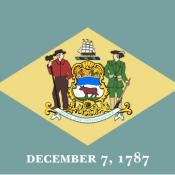 The flag of Delaware consists of a buff-colored diamond on a field of colonial blue, with the coat of arms of the state of Delaware inside the diamond. Below the diamond, the date December 7, 1787, declares the day on which Delaware became the first state to ratify the United States Constitution. The colors of the flag reflect the colors of the uniform of General George Washington.
The flag of Delaware consists of a buff-colored diamond on a field of colonial blue, with the coat of arms of the state of Delaware inside the diamond. Below the diamond, the date December 7, 1787, declares the day on which Delaware became the first state to ratify the United States Constitution. The colors of the flag reflect the colors of the uniform of General George Washington.
The coat of arms in the center of the flag was adopted on January 17, 1777. It depicts a shield of horizontal green, blue, and white stripes. On the stripes are a sheaf of wheat, an ear of corn, and an ox standing on grass, all representing Delaware’s agriculture. Above the shield is a sailing ship. Supporting the shield are a farmer on the left and a soldier on the right. The state motto, below the shield, reads “Liberty and Independence”. These symbols are also included on the seal of Delaware. The current flag was adopted on July 24, 1913.
Florida: 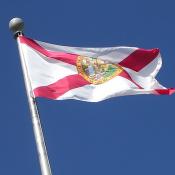 A red cross on a white field, with the seal of Florida superimposed at the center. The seal features a shoreline on which a Seminole woman is spreading flowers. Legend says that the woman is the historical heroine Milly Francis, but there is no documentation supporting this. Two Sabal palms (Florida’s state tree) are growing. In the background a steamboat sails before a sun breaking the horizon, with rays of sunlight extending into the sky. The seal is encircled with the words “Great Seal of the State of Florida”, and “In God We Trust” (the state motto).
A red cross on a white field, with the seal of Florida superimposed at the center. The seal features a shoreline on which a Seminole woman is spreading flowers. Legend says that the woman is the historical heroine Milly Francis, but there is no documentation supporting this. Two Sabal palms (Florida’s state tree) are growing. In the background a steamboat sails before a sun breaking the horizon, with rays of sunlight extending into the sky. The seal is encircled with the words “Great Seal of the State of Florida”, and “In God We Trust” (the state motto).
The original 1868 flag of Florida was simply the Florida state seal centered on a field of white. In the 1890’s, Florida’s governor suggested adding the red cross so the flag would not look like a banner of truce or surrender when hanging limp on a flagpole. Florida voters agreed and an amendment to Florida’s constitution was made in 1900 which describes the current design. The Florida state seal was adopted by the 1865 Legislature, which mandated that the seal be the size of the American silver dollar and display a scene in the center “of the sun’s rays over a high land in the distance, a cocoa tree, a steamboat on water, and an Indian female scattering flowers in the foreground, (all) encircled by the words Great Seal of the State of Florida: In God We Trust.”
In 1970 Florida’s official seal was updated. The cocoa tree became a Sabal palmetto palm (the state tree of Florida), the headdress was removed from the Native American woman (headdresses were only worn by men), and the woman was depicted as a Florida Seminole (originally she was dressed as a Native American of the western Plains).
Georgia:  Three stripes consisting of red-white-red, featuring a blue canton containing a ring of 13 white stars encompassing the state’s coat of arms in gold.
Three stripes consisting of red-white-red, featuring a blue canton containing a ring of 13 white stars encompassing the state’s coat of arms in gold.
Georgia adopted a new state flag in 2003. Georgia’s current flag has three bars of equal width – two outer red bars and a white bar in the center. There is a square blue canton the width of two bars in the upper left corner.
Georgia’s coat of arms is centered on the canton with the words “In God We Trust” below (both in gold). The state coat of arms is also the central design on the obverse [main face] of Georgia’s state seal. Circling the coat of arms are thirteen white stars (symbols of Georgia and the other twelve original states that formed the United States of America). The three pillars are symbols of the legislative, judicial and executive branches of government. The man standing with drawn sword defends the Constitution and its principles of “Wisdom, Justice and Moderation” (Georgia’s state motto).
Georgia leads the nation in the number and variety of different state flags it has flown.
Hawaii: 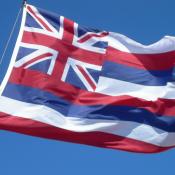 The current official flag of Hawaii (Hawaiian: Ka Hae Hawaiʻi) had also previously been used by the kingdom, protectorate, republic, and territory of Hawaii. The inclusion of an emblem of a foreign country, the Union Flag of the United Kingdom, is a mark of the British Empire’s historical relations with the Hawaiian Kingdom, and particularly with King Kamehameha I. It is the only US state flag to include a foreign country’s national flag.
The current official flag of Hawaii (Hawaiian: Ka Hae Hawaiʻi) had also previously been used by the kingdom, protectorate, republic, and territory of Hawaii. The inclusion of an emblem of a foreign country, the Union Flag of the United Kingdom, is a mark of the British Empire’s historical relations with the Hawaiian Kingdom, and particularly with King Kamehameha I. It is the only US state flag to include a foreign country’s national flag.
Eight alternating horizontal stripes of white, red, and blue, with the United Kingdom’s Union Flag in the canton.
Idaho: 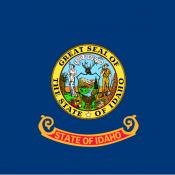 The flag of the state of Idaho consists of the state seal on a field of blue. The words “State of Idaho” appear in gold letters on a red and gold band below the seal. According to the official description of the flag, there should also be a fringe of gold around the edges, but a long time ago the versions of the flag were not shown until they remodeled the flag after War.[1]
The flag of the state of Idaho consists of the state seal on a field of blue. The words “State of Idaho” appear in gold letters on a red and gold band below the seal. According to the official description of the flag, there should also be a fringe of gold around the edges, but a long time ago the versions of the flag were not shown until they remodeled the flag after War.[1]
The seal depicts a miner and a woman representing equality, liberty, and justice. The symbols on the seal represent some of Idaho’s natural resources: mines, forests, farmland, and wildlife. The current seal contains the text “Great Seal of the State of Idaho” in the outer ring, with the star that signifies a new light in the galaxy of states. The inner ring contains a banner with the Latin motto, Esto perpetua (“Let it be perpetual” or “It is forever”).[2] A woman, signifying justice, and a man, dressed as a miner, support a shield. The miner represents the chief industry of the state at the time of statehood.
Inside, the shield bears images symbolic of the state. The pine tree in the foreground refers to Idaho’s immense timber interests. The husbandman plowing on the left side of the shield, together with the sheaf of grain beneath the shield, are emblematic of Idaho’s agricultural resources, while the two cornucopias, or horns of plenty, refer to the horticultural. Idaho has a game law, which protects the elk and moose, and an elk’s head rises above the shield. The state flower, the wild syringa or mock orange, grows at the woman’s feet, while the ripened wheat grows as high as her shoulder. The river depicted in the shield is the Snake or Shoshone River.
Illinois: 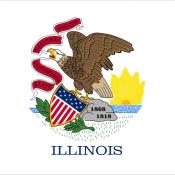 The Great Seal of the State of Illinois is the official emblem of the state, and signifies the official nature of a document produced by the state of Illinois. The flag of the state of Illinois consists of the seal of Illinois on a white background, with the word “Illinois” underneath the seal. The present seal was adopted in 1869, the flag bearing the central elements of the seal was adopted in 1915, and the word Illinois was added to the flag in 1970.
The Great Seal of the State of Illinois is the official emblem of the state, and signifies the official nature of a document produced by the state of Illinois. The flag of the state of Illinois consists of the seal of Illinois on a white background, with the word “Illinois” underneath the seal. The present seal was adopted in 1869, the flag bearing the central elements of the seal was adopted in 1915, and the word Illinois was added to the flag in 1970.
The Great Seal of the State of Illinois is the official emblem of the state, and signifies the official nature of a document produced by the state of Illinois. The flag of the state of Illinois consists of the seal of Illinois on a white background, with the word “Illinois” underneath the seal. The present seal was adopted in 1869, the flag bearing the central elements of the seal was adopted in 1915, and the word Illinois was added to the flag in 1970. The current flag depicts the Great Seal of Illinois, which was originally designed in 1819 and emulated the Great Seal of the United States. In the eagle’s beak there is a banner with the state motto, “State Sovereignty, National Union.” The dates on the seal, 1818 and 1868, represent the year Illinois became a state and the year in which the Great Seal was redesigned by Sharon Tyndale. Although “State Sovereignty” comes first in the motto, “State” is at the bottom and “Sovereignty” is upside-down.
Indiana:  A gold torch surrounded by an outer circle of thirteen stars, an inner semi circle of five stars, and a 19th, larger, star at the top of the torch, crowned by the word ‘Indiana’, representing Indiana’s admission to the Union as the 19th state.
A gold torch surrounded by an outer circle of thirteen stars, an inner semi circle of five stars, and a 19th, larger, star at the top of the torch, crowned by the word ‘Indiana’, representing Indiana’s admission to the Union as the 19th state.
Iowa: 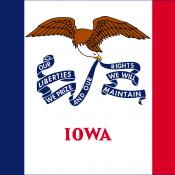 A vertical tricolor consisting of blue, white, red. The center stripe is twice the width of the other two and contains an eagle holding a ribbon.
A vertical tricolor consisting of blue, white, red. The center stripe is twice the width of the other two and contains an eagle holding a ribbon.
The flag of the state of Iowa is a vertical tricolor of blue, white, and red, reflecting the U.S. state of Iowa’s history as part of the French Louisiana Territory. (Because of the wider middle stripe and symmetric design, the design is sometimes classified[by whom?] as a “Canadian pale”). The image of a bald eagle with a long ribbon reading “Our liberties we prize and our rights we will maintain,” derived from the Seal of Iowa, is centered in the middle white stripe. The word “Iowa” is placed directly below it in red, serifed majuscules. The flag was adopted in 1921; it was first approved in May 1917, by the Iowa State Council for Defense. It was designed in 1917, by Knoxville, Iowa, resident Mrs. Dixie Cornell Gebhardt, of the Daughters of the American Revolution of Iowa[1] and was updated In 2018.[2]
Kansas: 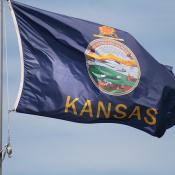 Seal of Kansas on a field of azure, a sunflower is displayed above the seal and the word “Kansas” below. The state seal centered on the flag tells the history of Kansas and his figures representing pioneer life. The seal contains:
Seal of Kansas on a field of azure, a sunflower is displayed above the seal and the word “Kansas” below. The state seal centered on the flag tells the history of Kansas and his figures representing pioneer life. The seal contains:
Landscape with a rising sun (the east)
River and steamboat (commerce)
Settler’s cabin and a man plowing a field (agriculture) [foreground]
Wagon train heading west (American expansion)
Indians hunting American Bison (the buffalo are fleeing from the Indians)
Cluster of 34 stars (top of the seal)
State motto “Ad Astra per Aspera” – Latin : “To the Stars through Difficulties” (above the stars)
The thirty-four stars clustered at the top of the seal identify Kansas as the 34th state to be accepted into the Union of the United States.[2] Kansas state law provides that the flag is to be used on all occasions when the state is officially represented
Kentucky: 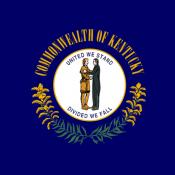 Seal of Kentucky on a field of azure. The Seal of the Commonwealth of Kentucky was adopted in December 1792. Since that time, it has undergone several revisions. The current seal depicts two men, one in buckskin, and the other in more formal dress. The men are facing each other and clasping hands. The outer ring of the seal is adorned with the words “Commonwealth of Kentucky”, and within the inner circle is the state motto “United we stand, divided we fall.” The official colors of the seal are blue and gold.[1] A version of the seal appears on the flag of Kentucky.
Seal of Kentucky on a field of azure. The Seal of the Commonwealth of Kentucky was adopted in December 1792. Since that time, it has undergone several revisions. The current seal depicts two men, one in buckskin, and the other in more formal dress. The men are facing each other and clasping hands. The outer ring of the seal is adorned with the words “Commonwealth of Kentucky”, and within the inner circle is the state motto “United we stand, divided we fall.” The official colors of the seal are blue and gold.[1] A version of the seal appears on the flag of Kentucky.
Louisiana: 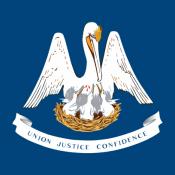 The flag of Louisiana (French: Drapeau de la Louisiane) consists of a “pelican in her piety,” the heraldic charge representing a mother pelican “in her nest feeding her young with her blood[,]”[2] on an azure field with state motto reworded to “Union Justice Confidence.” First adopted in 1912,[3] it was last modified in 2010. Image of a pelican feeding her young with her own blood on a field of azure. Below the pelican, a ribbon displays “Union Justice Confidence”
The flag of Louisiana (French: Drapeau de la Louisiane) consists of a “pelican in her piety,” the heraldic charge representing a mother pelican “in her nest feeding her young with her blood[,]”[2] on an azure field with state motto reworded to “Union Justice Confidence.” First adopted in 1912,[3] it was last modified in 2010. Image of a pelican feeding her young with her own blood on a field of azure. Below the pelican, a ribbon displays “Union Justice Confidence”
Maine:  Maine coat of arms defacing blue field. The Great Seal of the State of Maine was adopted in June 1820. There have been variations in the details of the seal, but the overall design and images remain true to the original. The center of the seal is a shield adorned with a tranquil scene of a moose resting in a field bordered by water and woods; a pine tree stands tall directly behind the moose. On either side of the shield, a farmer rests on his scythe, and a sailor leans on an anchor. Above the shield is the motto “Dirigo” (I direct) and a stylized North Star. Below the shield is a banner that reads “Maine”. The legislature of 1919 decided that the design of the seal should no longer vary, and the design is still used today.
Maine coat of arms defacing blue field. The Great Seal of the State of Maine was adopted in June 1820. There have been variations in the details of the seal, but the overall design and images remain true to the original. The center of the seal is a shield adorned with a tranquil scene of a moose resting in a field bordered by water and woods; a pine tree stands tall directly behind the moose. On either side of the shield, a farmer rests on his scythe, and a sailor leans on an anchor. Above the shield is the motto “Dirigo” (I direct) and a stylized North Star. Below the shield is a banner that reads “Maine”. The legislature of 1919 decided that the design of the seal should no longer vary, and the design is still used today.
Maryland: 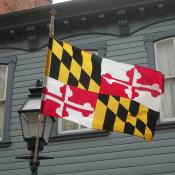 Heraldic banner of George Calvert, 1st Baron Baltimore
Heraldic banner of George Calvert, 1st Baron Baltimore
Massachusetts:  The flag of the Commonwealth of Massachusetts is the flag of Massachusetts. It has been represented by official but limited-purpose flags since 1776, though until 1908 it had no state flag per se to represent its government. A variant of the white flag with blue seal was carried by each of the Massachusetts volunteer regiments during the Civil War alongside the National Colors. An exception were the two “Irish regiments” (the 9th and 28th Volunteers), each of which was permitted to carry an alternative green flag with a harp symbol. The state currently has three official flags: a state flag, a “naval and maritime flag” (despite it no longer having its own navy), and a governor’s flag. With Florida and Minnesota, it is one of only three state flags to prominently feature a Native American in its heraldry. The flag of the Commonwealth of Massachusetts displays, on both sides, the state coat of arms centered on a white field. The shield depicts an Algonquian Native American with bow and arrow; the arrow is pointed downward, signifying peace. A white star with five points appears next to the figure’s head, signifying Massachusetts as a U.S. state. A blue ribbon surrounds the shield, bearing the state motto Ense Petit Placidam, Sub Libertate Quietem (“By the Sword We Seek Peace, But Peace Only Under Liberty”).[1] Above the shield is the state military crest: the bent arm holding a broadsword aloft. The sword has its blade up, to remind that it was through the American Revolution that liberty was won. The arm itself is of Myles Standish[2] and signifies the philosophy that one would rather lose their right arm than live under tyranny.[3]
The flag of the Commonwealth of Massachusetts is the flag of Massachusetts. It has been represented by official but limited-purpose flags since 1776, though until 1908 it had no state flag per se to represent its government. A variant of the white flag with blue seal was carried by each of the Massachusetts volunteer regiments during the Civil War alongside the National Colors. An exception were the two “Irish regiments” (the 9th and 28th Volunteers), each of which was permitted to carry an alternative green flag with a harp symbol. The state currently has three official flags: a state flag, a “naval and maritime flag” (despite it no longer having its own navy), and a governor’s flag. With Florida and Minnesota, it is one of only three state flags to prominently feature a Native American in its heraldry. The flag of the Commonwealth of Massachusetts displays, on both sides, the state coat of arms centered on a white field. The shield depicts an Algonquian Native American with bow and arrow; the arrow is pointed downward, signifying peace. A white star with five points appears next to the figure’s head, signifying Massachusetts as a U.S. state. A blue ribbon surrounds the shield, bearing the state motto Ense Petit Placidam, Sub Libertate Quietem (“By the Sword We Seek Peace, But Peace Only Under Liberty”).[1] Above the shield is the state military crest: the bent arm holding a broadsword aloft. The sword has its blade up, to remind that it was through the American Revolution that liberty was won. The arm itself is of Myles Standish[2] and signifies the philosophy that one would rather lose their right arm than live under tyranny.[3]
The state flag was officially adopted in 1908, but had been used unofficially since the American Revolutionary War as the ensign of the Massachusetts State Navy. In 1971, the earlier pine tree was replaced by the current design
Michigan: 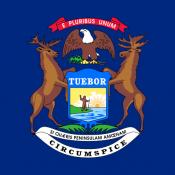 The state coat of arms depicts a blue shield, upon which the sun rises over a lake and peninsula, and a man with a raised hand representing peace and holding a long gun representing the fight for state and nation as a frontier state.[3]
The state coat of arms depicts a blue shield, upon which the sun rises over a lake and peninsula, and a man with a raised hand representing peace and holding a long gun representing the fight for state and nation as a frontier state.[3]
As supporters, the elk and moose are derived from the Hudson’s Bay Company coat of arms, and depict great animals of Michigan. The bald eagle represents the United States which formed the state of Michigan from the Northwest Territory.[4]
The design features three Latin mottos. From top-to-bottom they are:
On red ribbon: “E Pluribus Unum,” means “Out of many, one,” a motto of the United States.
On light blue shield: “Tuebor,” means “I will defend.”
On white ribbon: “Si Quæris Peninsulam Amœnam Circumspice,” means “If you seek a pleasant peninsula, look about you.” (The official state motto).
Minnesota: 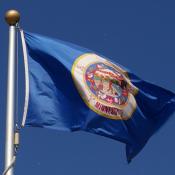 State seal on a medium blue field. The sun, visible on the western horizon, signifies summer in the northern hemisphere. The horizon’s visibility signifies the flat plains covering much of Minnesota. The American Indian on horseback is riding towards the south and represents the American Indian heritage of Minnesota. The Indian’s horse and spear and the Pioneer’s ax, rifle, and plow represent tools that were used for hunting and labor. The stump symbolizes the importance of the lumber industry in Minnesota’s history. The Mississippi River and St. Anthony Falls are depicted to note the importance of these resources in transportation and industry. The cultivated ground and the plow symbolize the importance of agriculture in Minnesota. Beyond the falls three pine trees represent the state tree and the three pine regions of Minnesota; the St. Croix, Mississippi, and Lake Superior.[3]
State seal on a medium blue field. The sun, visible on the western horizon, signifies summer in the northern hemisphere. The horizon’s visibility signifies the flat plains covering much of Minnesota. The American Indian on horseback is riding towards the south and represents the American Indian heritage of Minnesota. The Indian’s horse and spear and the Pioneer’s ax, rifle, and plow represent tools that were used for hunting and labor. The stump symbolizes the importance of the lumber industry in Minnesota’s history. The Mississippi River and St. Anthony Falls are depicted to note the importance of these resources in transportation and industry. The cultivated ground and the plow symbolize the importance of agriculture in Minnesota. Beyond the falls three pine trees represent the state tree and the three pine regions of Minnesota; the St. Croix, Mississippi, and Lake Superior.[3]
In the original version, the Indian is dressed in his war costumes while the farmer is in the field with his firearm. There seems to have been great tension between certain tribes of the Sioux and the settlers. “The Indian’s Revenge[4]” by Alexander Berghold, writes about an outbreak of Indian attacks which started much as the scene in the original seal. The author makes the statement that after the attacks, settlers were allowed to kill any Sioux that was found in a settlement and that no settler left their home without their rifle. He goes on to say, “The seal of the State, therefore, seems very appropriate.”
The first seal was adopted in 1858 and the attacks were in 1862.
Mississippi: 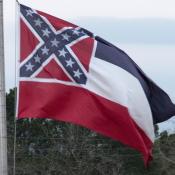 The flag of Mississippi, often referred to as the Mississippi flag, is the state flag of the U.S. state of Mississippi. It consists of three equal horizontal tribands of blue, white, and red, with a red square in the canton (referred to specifically as the “union”) bearing a blue cross, bordered with white and emblazoned with thirteen small, white, five-pointed stars. The 13 stars on the flag correspond to the original number of the states of the Union.[1] The current design was adopted in 1894.[1] Three equal horizontal tribands of blue, white, and red. The canton is square, bearing a blue cross, consists of a red background with a blue saltire, bordered with white, and emblazoned with thirteen (13) five-pointed stars
The flag of Mississippi, often referred to as the Mississippi flag, is the state flag of the U.S. state of Mississippi. It consists of three equal horizontal tribands of blue, white, and red, with a red square in the canton (referred to specifically as the “union”) bearing a blue cross, bordered with white and emblazoned with thirteen small, white, five-pointed stars. The 13 stars on the flag correspond to the original number of the states of the Union.[1] The current design was adopted in 1894.[1] Three equal horizontal tribands of blue, white, and red. The canton is square, bearing a blue cross, consists of a red background with a blue saltire, bordered with white, and emblazoned with thirteen (13) five-pointed stars
Missouri: 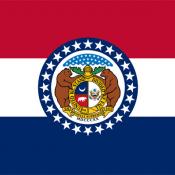 A horizontal tricolor of red, white and blue. The Missouri Seal, surrounded by a blue band and stars, is superimposed in the field center. The Great Seal of the State of Missouri was adopted on January 11, 1822. Judge Robert William Wells designed the seal [1]. The center of the seal contains the Great Seal of the United States on the right side, and, on the left, symbols representing the state. On both sides of the center circle, a bear represents strength and bravery; a crescent moon represents the newness of statehood and the potential for growth. Surrounding these symbols is the motto “United we stand, divided we fall”. The belt buckle signifies the State’s ability to secede from the Union if deemed necessary, i.e., the belt can be unbuckled. Two mighty grizzly bears support this center shield. A scroll carries the state motto, Salus populi suprema lex esto, a Latin phrase meaning “Let the welfare of the people be the supreme law.” The year 1820 is inscribed in Roman numerals below the scroll, although Missouri was not officially granted statehood until 1821. A star representing each of the other states of the Union (Missouri became the 24th) graces the top portion of the seal. The outer circle of the seal bears the words “The Great Seal of the State of Missouri”. Above the shield is a helmet representing Missouri’s state sovereignty. The large star above the helmet surrounded by 23 smaller stars represents Missouri’s status as the 24th state. The cloud around the stars indicates the problems Missouri had in becoming a state.
A horizontal tricolor of red, white and blue. The Missouri Seal, surrounded by a blue band and stars, is superimposed in the field center. The Great Seal of the State of Missouri was adopted on January 11, 1822. Judge Robert William Wells designed the seal [1]. The center of the seal contains the Great Seal of the United States on the right side, and, on the left, symbols representing the state. On both sides of the center circle, a bear represents strength and bravery; a crescent moon represents the newness of statehood and the potential for growth. Surrounding these symbols is the motto “United we stand, divided we fall”. The belt buckle signifies the State’s ability to secede from the Union if deemed necessary, i.e., the belt can be unbuckled. Two mighty grizzly bears support this center shield. A scroll carries the state motto, Salus populi suprema lex esto, a Latin phrase meaning “Let the welfare of the people be the supreme law.” The year 1820 is inscribed in Roman numerals below the scroll, although Missouri was not officially granted statehood until 1821. A star representing each of the other states of the Union (Missouri became the 24th) graces the top portion of the seal. The outer circle of the seal bears the words “The Great Seal of the State of Missouri”. Above the shield is a helmet representing Missouri’s state sovereignty. The large star above the helmet surrounded by 23 smaller stars represents Missouri’s status as the 24th state. The cloud around the stars indicates the problems Missouri had in becoming a state.
Salus populi suprema lex esto (Latin “Let the good of the people be the supreme law” or “The welfare of the people shall be the supreme law”) is found in Cicero’s De Legibus (book III, part III, sub. VIII), as Ollis salus populi suprema lex esto.[2]
The phrase is the state motto of Missouri, accepted in its state seal. It is also the motto, and appears on the coat of arms, of the City of Salford, the London Borough of Lewisham, the Duquesne University School of Law, and is used as the motto of the Vlaams Belang political group in the Belgian Chamber of Representatives. John Locke uses it as the epigraph in his Second Treatise on Government and refers to it as a fundamental rule for government.
Montana: 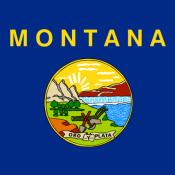 Seal of Montana on a blue field. Above the seal the text “Montana”. The Great Seal of the State of Montana was adopted in 1865, when Montana was a United States Territory. When it became a state in 1889, it was decided to use the same seal. In 1891, proposals were made to make changes or adopt a brand new seal. None of these proposals passed legislation. The outer ring of the seal contains the text “The Great Seal of the State of Montana”. The inner circle depicts a landscape of mountains, plains and forests by the Great Falls on the Missouri River. A plow, a pick and a shovel are depicted on the front, representing the state’s industry.[1] The banner at the bottom of the seal reads the territorial motto of Oro y Plata, meaning “Gold and Silver” in Spanish.[2]
Seal of Montana on a blue field. Above the seal the text “Montana”. The Great Seal of the State of Montana was adopted in 1865, when Montana was a United States Territory. When it became a state in 1889, it was decided to use the same seal. In 1891, proposals were made to make changes or adopt a brand new seal. None of these proposals passed legislation. The outer ring of the seal contains the text “The Great Seal of the State of Montana”. The inner circle depicts a landscape of mountains, plains and forests by the Great Falls on the Missouri River. A plow, a pick and a shovel are depicted on the front, representing the state’s industry.[1] The banner at the bottom of the seal reads the territorial motto of Oro y Plata, meaning “Gold and Silver” in Spanish.[2]
Nebraska: 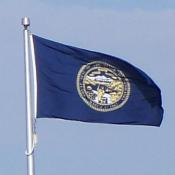 Nebraska was one of the last states to adopt a state flag. Representative J. Lloyd McMaster introduced a bill in 1925 to designate a state banner and the bill was passed. The law describes the banner as: “… a reproduction of the Great Seal of the State charged on the center in gold and silver on a field of national blue.”
Nebraska was one of the last states to adopt a state flag. Representative J. Lloyd McMaster introduced a bill in 1925 to designate a state banner and the bill was passed. The law describes the banner as: “… a reproduction of the Great Seal of the State charged on the center in gold and silver on a field of national blue.”
In 1963 the Legislature finally designated the state banner as the official flag of Nebraska. The symbols on the great seal of Nebraska are described on a bill introduced in 1867:
“The eastern part of the circle to be represented by a steamboat ascending the Missouri River, the mechanic arts to be represented by a smith with a hammer and anvil, in the foreground, agriculture to be represented by a settlers cabin, sheaves of wheat, and stalks of growing corn, in the background a train of cars heading towards the Rocky Mountains, and on the extreme west, the Rocky Mountains to be plainly in view, around the top of the circle, to be in capital letters, the motto: “Equality Before the Law,” and the circle to be surrounded with the words, “Great Seal of the State of Nebraska.”
The Great Seal of Nebraska is protected by state law (graphic images of the state seal are not in the public domain). The restrictions on the use of the state seal also apply to Nebraska’s state flag (the state seal is the flag’s centerpiece). Requests for permission to use images of the Nebraska state seal or state flag must be made in writing to the Secretary of State.
Neither this website, nor the information presented on this website is endorsed by the state of Nebraska or Nebraska’s Secretary of State.
Nevada: 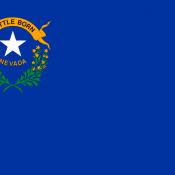 Nevada has had four state flags during its history. The first flag was adopted in 1905 (over 40 years after Nevada became a state in 1864). The current flag of Nevada was was approved in 1991. All State Flags
Nevada has had four state flags during its history. The first flag was adopted in 1905 (over 40 years after Nevada became a state in 1864). The current flag of Nevada was was approved in 1991. All State Flags
Nevada’s flag has a cobalt blue background. A five-pointed silver star (silver is the state metal) is positioned in the upper left quarter of the flag between two sprays of sagebrush that cross to form a half-wreath (sagebrush is Nevada’s state flower, and one of Nevada’s nicknames is “The Sagebrush State”).
Across the top of the wreath is a golden scroll with the words “Battle Born” in black letters. The phrase “Battle Born” signifies that Nevada entered the Union during the Civil War. Below the star, in golden letters, is the name “Nevada.”
New Hampshire: 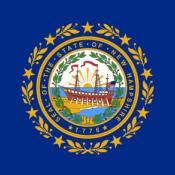 New Hampshire’s state flag features the state seal with the frigate Raleigh surrounded by laurel leaves and nine stars against a field of blue. New Hampshire did not officially adopt a state flag until 1909.
New Hampshire’s state flag features the state seal with the frigate Raleigh surrounded by laurel leaves and nine stars against a field of blue. New Hampshire did not officially adopt a state flag until 1909.
New Jersey: 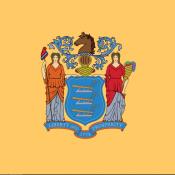 In 1780, during the Revolutionary war, General George Washington directed that the regiments of the New Jersey Continental Line have a flag of dark blue and buff (buff and Jersey blue are now recognized as the official state colors of New Jersey). All State Flags
In 1780, during the Revolutionary war, General George Washington directed that the regiments of the New Jersey Continental Line have a flag of dark blue and buff (buff and Jersey blue are now recognized as the official state colors of New Jersey). All State Flags
General Washington presumably selected these colors for historic reasons; New York and New Jersey were both originally settled by the Dutch, and dark blue (Jersey blue) and buff were Holland’s (the Netherlands) insignia. The center of the flag features New Jersey’s coat of arms (featured on the great seal of New Jersey).
Symbols on New Jersey’s Coat of Arms
Three plows on the shield honor the state’s agricultural tradition. The helmet above the shield faces forward, an attitude denoting sovereignty (fitting for one of the first governments created under the notion that the state itself is the sovereign). The crest above the helmet is a horse’s head (the horse is also New Jersey’s official state animal).
The supporting female figures are Liberty and Ceres (Roman goddess of grain – a symbol of abundance). Liberty carries the liberty cap on her staff and Ceres holds a cornucopia filled with harvested produce; they are supported by a banner that reads “Liberty and Prosperity” (New Jersey’s state motto).
New Mexico: 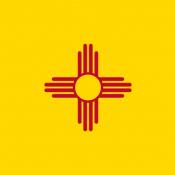 The colors on New Mexico’s state flag are the red and yellow of old Spain. The simple, elegant center design is the ancient Zia sun symbol, which represents the unique character of New Mexico (Zia sun symbol also appears on New Mexico’s state quarter).
The colors on New Mexico’s state flag are the red and yellow of old Spain. The simple, elegant center design is the ancient Zia sun symbol, which represents the unique character of New Mexico (Zia sun symbol also appears on New Mexico’s state quarter).
The Zia Indians of New Mexico regard the Sun as sacred. Their symbol for the sun (a red circle with groups of rays pointing in four directions) is painted on ceremonial vases, drawn on the ground around campfires, and used to introduce newborns to the Sun.
Four is the sacred number of the Zia and is seen repeated in the four points radiating from the circle, each consisting of four bars. To the Zia Indians, the number four represents:
the four points of the compass (east, west, north, and south);
the four seasons of the year (spring, summer, autumn, and winter);
the four periods of each day (morning, noon, evening, and night);
the four seasons of life (childhood, youth, middle years, and old age);
the Zia’s belief that with life comes four sacred obligations: one must develop a strong body, a clear mind, a pure spirit, and a devotion to the welfare of others.
New York: 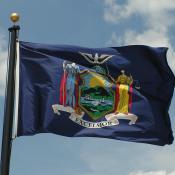
Official State Flag of New York
The New York state flag features the state’s coat of arms on a field of deep blue. Although the state flag wasn’t adopted until 1901, New York’s coat of arms was officially adopted in 1778 (the state seal also features New York’s coat of arms). All State Flags
Symbols on the Flag
The center shield displays a masted ship and a sloop on the Hudson River river (symbols of inland and foreign commerce), bordered by a grassy shore and a mountain range in the background with the sun rising behind it. A banner below shows New York’s state motto (“Excelsior,” Latin for “ever upward”).
Liberty and Justice support the shield and an American bald eagle spreads its wings above on a world globe. Liberty’s left foot treads on a crown (a symbol of freedom from the Kingdom of Great Britain). Justice is blindfolded and holds a sword in one hand and a scale in the other, symbolizing impartiality and fairness.
North Carolina: 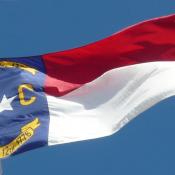 A state flag for North Carolina was not established until 1861 when the constitutional convention passed the ordinance of secession which read:
A state flag for North Carolina was not established until 1861 when the constitutional convention passed the ordinance of secession which read:
“(The flag) … shall consist of a red field with a white star in the centre, and with the inscription, above the star, in a semi-circular form, of “May 20th, 1775,” and below the star, in a semi-circular form, of “May 20th, 1861.” That there shall be two bars of equal width, and the length of the field shall be equal to the bar, the width of the field being equal to both bars: the first bar shall be blue, and second shall be white: and the length of the flag shall be one-third more than its width.”
This flag was used by North Carolina troops during the Civil War and existed until 1885 when a new design was adopted:
SEC. 1. That the flag of North Carolina shall consist of a blue union, containing in the centre thereof a white star with the letter N in gilt on the left and the letter C in gilt on the right of said star, the circle containing the same to be one-third the width of the union.
SEC. 2. That the fly of the flag shall consist of two equally proportioned bars; the upper bar to be red, the lower bar to be white; that the length of the bars horizontally shall be equal to the perpendicular length of the union, and the total length of the flag shall be one-third more than its width.
SEC. 3. That above the star in the centre of the union there shall be a gilt scroll in semi-circular form, containing in black letters this inscription “May 20th, 1775,” and that below the star there shall be similar scroll containing in black letters the inscription: “April 12th, 1776.”
The date May 20, 1775 refers to the Mecklenburg Declaration of Independence (though historians debate the authenticity of this document and so many North Carolinians question the legitimacy of having this date on the state flag).
The May 20th, 1861 date commemorated North Carolina’s secession from the Union. This second date was replaced in 1885 with “April 12th, 1776.” to commemorate the Halifax Resolves, a document that places North Carolina in the front rank among those that demanded unconditional freedom and absolute independence from any foreign power (considered a great landmarks in the annals of North Carolina history).
This flag remained unchanged for over 100 years until 1991 when minor changes were made (commas were removed from the dates and the total length of the flag was changed to “one-half more than the width.”
North Dakota: 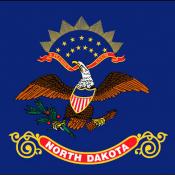 Adopted in 1911, the state flag of North Dakota features a bald eagle holding an olive branch and a bundle of arrows in its talons. The eagle carries a ribbon in its beak saying “E Pluribus Unum” (Latin for “out of many, one”) symbolizing one nation made up of many states. A shield with thirteen stripes on the eagle’s breast represents the original thirteen states.
Adopted in 1911, the state flag of North Dakota features a bald eagle holding an olive branch and a bundle of arrows in its talons. The eagle carries a ribbon in its beak saying “E Pluribus Unum” (Latin for “out of many, one”) symbolizing one nation made up of many states. A shield with thirteen stripes on the eagle’s breast represents the original thirteen states.
The fan-shape with thirteen stars above the bald eagle is a symbol for the birth of a new nation, the United States. The name of the state – North Dakota – appears below the eagle on a red scroll. The design is centered on a field of dark blue.
The state flag conforms to the color, design, and size of the regimental flag that was carried by North Dakota Infantry in the Spanish-American War in 1898 and Philippine Island Insurrection in 1899 (the only difference are the words “North Dakota” on the scroll below the eagle).
In 1951 a state flag commission concluded that the flag “too closely resembled the coat of arms of the United States and that the flag was not symbolic of North Dakota,” but this conclusion was widely challenged and suggested changes to the flag were rejected by North Dakota Legislature in 1953. All State Flags
Ohio: 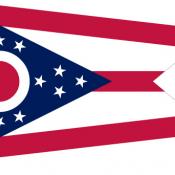 The Ohio state flag has a unique swallowtail design which is more correctly called a burgee (pronounced bûr’je) rather than a “flag” or “banner.” All other state flags have a square or rectangular shape. All State Flags
The Ohio state flag has a unique swallowtail design which is more correctly called a burgee (pronounced bûr’je) rather than a “flag” or “banner.” All other state flags have a square or rectangular shape. All State Flags
The Ohio flag was designed by John Eisemann and officially adopted in 1902. The blue triangular field represents Ohio’s hills and valleys. It contains seventeen white stars – thirteen stars surrounding the circle are symbols of the original thirteen colonies. Four stars at the apex of the triangle raise the total number of stars to seventeen (Ohio was the 17th state to enter the Union in 1803).
The red and white stripes represent the roads and waterways of the state. The white circle with a red center forms an “O” for “Ohio” and is also related to Ohio’s nickname (The Buckeye State).
Oklahoma: 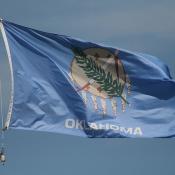 The current state flag of Oklahoma, designed by Louise Fluke, was adopted in 1925 (Oklahoma had 13 previous flags). All State Flags
The current state flag of Oklahoma, designed by Louise Fluke, was adopted in 1925 (Oklahoma had 13 previous flags). All State Flags
The blue field signifies devotion, the shield is a symbol of defensive or protective warfare, but always surmounted by the olive branch and peace pipe which betoken the love of peace by a united people.
Official Salute to the Oklahoma State Flag
“I salute the flag of the State of Oklahoma. Its symbols of peace unite all people.”
Description of the flag from official statutes:
SECTION 1. AMENDATORY 25 O.S. 2001, Section 91, is amended to read as follows:
A. The banner, or flag, of the design prescribed by Senate Concurrent Resolution No. 25, Third Legislature of the State of Oklahoma shall be, and it hereby is superseded and replaced by one of the following design, to wit:
A sky blue field with a circular rawhide shield of an American Indian Warrior, decorated with six painted crosses* on the face thereof, the lower half of the shield to be fringed with seven pendant eagle feathers and superimposed upon the face of the shield a calumet or peace pipe, crossed at right angles by an olive branch, as illustrated by the design accompanying this resolution, and underneath said shield or design in white letters shall be placed the word “Oklahoma”, and the same is hereby adopted as the official flag and banner of the State of Oklahoma.
B. The standard design and colors in the state flag shall be as follows:
1. The Osage Indian warrior’s circular rawhide shield of amber buckskin is center upon a field of French Blue. On the face of the shield shall be six small gold brown crosses that match the thongs lacing the edge of the shield. The vertical bar of each cross shall be twenty-five percent (25%) longer than the horizontal bar, the lower width line of which shall be placed at the fifty percent (50%) mark of the vertical bar and the top width line shall be placed at the top twenty-five percent (25%) mark of the vertical bar. The width of the horizontal bar shall be seventy-five percent (75%) of the vertical bar;
2. The edge of the lower half of the shield shall be fringed with seven pendant eagle feathers of white tipped with gold brown;
3. Across the face of the shield at right angle shall be a calumet or Indian pipe of peace, which shall have a ruby red bowl, flesh stem and be decorated with a ruby red tassel at the end. Above the calumet, lying at a right angle shall be an olive branch of Dartmouth green; and
4. The name Oklahoma in white letters shall appear under the shield on the face of the flag.
C. The standard colors used in production of the state flag shall be:
1. Pantone Matching System, Pantone Inc., latest edition:
a. field: French Blue PMS 285c,
b. shield: amber PMS 465c,
c. feathers shading: flesh and gold brown combination PMS 486c and PMS 174c,
d. crosses and thongs: gold brown PMS 174c, and
e. calumet: stem of pipe flesh PMS 486c, body of pipe and tassel ruby red PMS 195c, and olive branch Dartmouth green PMS 554c; and
2. Colors shall be colorfast and shall not bleed one into another.
SECTION 2. NEW LAW A new section of law to be codified in the Oklahoma Statutes as Section 91a of Title 25, unless there is created a duplication in numbering, reads as follows:
It shall be the duty of all state agencies and boards of education of this state to display the state flag with the standard design and colors as specified in Section 91 of Title 25 of the Oklahoma Statutes.
SECTION 3. This act shall become effective November 1, 2006.”
*Crosses are the Native American symbol for stars.
Oregon: 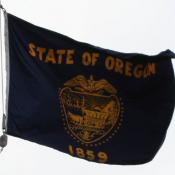 The Oregon state flag was adopted in 1925 and is the only U.S. state flag that displays different images on front and back. All State Flags
The Oregon state flag was adopted in 1925 and is the only U.S. state flag that displays different images on front and back. All State Flags
The Oregon flag has gold lettering and symbols on a field of navy blue (Oregon’s state colors). The flag’s face displays part of the state seal and the words “STATE OF OREGON” and “1859” (the year Oregon was admitted to the Union). The parade flag (or “dress flag”) has a gold fringe, but the utility flag has a plain border.
The symbols on the shield include the mountains and forests of Oregon, an elk with branching antlers, a covered wagon and ox team, the Pacific Ocean with a setting sun, a departing British man-of-war ship (a symbol of the departure of British influence in the region) and an arriving American merchant ship (a symbol of the rise of American power). The 33 stars supporting the shield signify that Oregon was the 33rd state to join the Union.
The reverse of the flag pictures Oregon’s official state animal – the beaver (Oregon’s nickname is The Beaver State, stemming from the early 19th century when fur hats were fashionable and Oregon’s streams were an important source of beaver).
Pennsylvania: 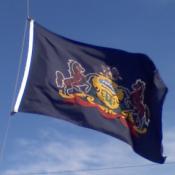 The first state flag of Pennsylvania was authorized by the General Assembly in 1799. A law was passed in 1907 standardizing the flag and requiring that the blue field match the blue of “Old Glory” (the national flag). All State Flags
The first state flag of Pennsylvania was authorized by the General Assembly in 1799. A law was passed in 1907 standardizing the flag and requiring that the blue field match the blue of “Old Glory” (the national flag). All State Flags
Pennsylvania’s flag features the state coat of arms on a field of blue. The state motto appears on a ribbon at the base of the design (“Liberty, Virtue, Independence”). The Pennsylvania coat of arms is also featured on the state seal.
Rhode Island: 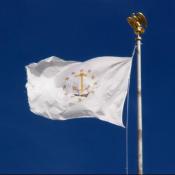 The flag of Rhode Island is white, bearing on each side in the center a gold anchor, underneath it a blue ribbon with the state motto (“Hope”) in gold letters, and surrounded by thirteen golden stars in a circle, representing the original 13 states. The flag design adopted in 1877 also stipulated that; “The flag shall be edged with yellow fringe.” All State Flags
The flag of Rhode Island is white, bearing on each side in the center a gold anchor, underneath it a blue ribbon with the state motto (“Hope”) in gold letters, and surrounded by thirteen golden stars in a circle, representing the original 13 states. The flag design adopted in 1877 also stipulated that; “The flag shall be edged with yellow fringe.” All State Flags
The Rhode Island General Assembly first adopted a seal for the colony in 1664 which contained an anchor with the word “Hope” above it (Rhode Island’s state seal). The use of the word “Hope” was probably inspired by the biblical phrase “hope we have as an anchor of the soul.”
South Carolina: 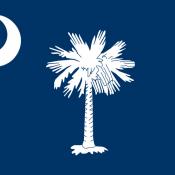 The state flag of South Carolina was adopted on January 28, 1861. The crescent symbol represents the silver emblem worn on the caps of South Carolina troops during the revolutionary war, and the background color matches the blue of their uniforms. Crescents were also a component of a banner carried by South Carolina protesters of the Stamp Act in 1776.
The state flag of South Carolina was adopted on January 28, 1861. The crescent symbol represents the silver emblem worn on the caps of South Carolina troops during the revolutionary war, and the background color matches the blue of their uniforms. Crescents were also a component of a banner carried by South Carolina protesters of the Stamp Act in 1776.
The flag also features the state tree (sabal palmetto). South Carolina’s nickname is the palmetto state, a sabal palmetto tree appears on the state seal, and also on the U.S. Mint’s quarter for South Carolina. The iconic sabal palm is also the state tree of Florida; all state trees – all state flags.
South Dakota: 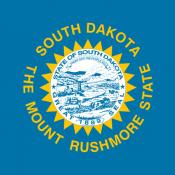 Official State Flag of South Dakota
Official State Flag of South Dakota
The state flag of South Dakota features the great seal on a blazing sun in the center against a field of sky blue. The words “South Dakota” appear above the seal and the official state nickname appears below; “The Mount Rushmore State.” South Dakota flags that are designed for indoor and display use have a golden fringe on three sides. All State Flags
The symbols on the great seal of South Dakota represent the state’s commerce, industry, and natural resources. “Under God the People Rule” (South Dakota’s state motto) appears at the top of the inner circle, which has a background of sky and hills. In the foreground, a steam ship navigates a river running through agricultural and industrial land. The outer circle of the seal bears the words “State of South Dakota,” “Great Seal,” and “1889” (the year South Dakota became a state).
Tennessee: 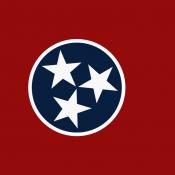 The state flag of Tennessee has three stars representing the “grand divisions” of the state: East, Middle, and West. The stars are “bound together in indissoluble unity by an unending white band” (officially adopted in 1905). All State Flags
The state flag of Tennessee has three stars representing the “grand divisions” of the state: East, Middle, and West. The stars are “bound together in indissoluble unity by an unending white band” (officially adopted in 1905). All State Flags
Tennessee’s flag was designed by LeRoy Reeves of the Third Regiment, Tennessee Infantry. His explanation of the design:
“The three stars are of pure white, representing the three grand division of the state. They are bound together by the endless circle of the blue field, the symbol being three bound together in one – an indissouluble trinity. Thelarge field is crimson. The final blue bar relieves the sameness of the crimson field and prevents the flag from showing too much crimson when hanging limp. The white edgings contrast more strongly the other colors.”
Six different national flags have flown over Texas representing the countries which have ruled it (France, Spain, Mexico, the Republic of Texas, the Confederate States of America, and the United States of America). Texans proudly wave all six official flags for public displays and expositions.
A rarely-mentioned seventh flag flew over the new Republic of Texas for three years, beginning in 1836. The flag had a blue field with a single gold star in the center, fashioned after the flag of the short-lived Republic of West Florida. That flag symbolized independence and was later used by the Confederate States of America as the “Bonnie Blue Flag;” the lone star remains on the official Texas flag of today (the gold star now white).
Utah: 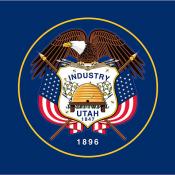 Utah’s flag features the state seal against a field of blue. The date 1847 is the year the Mormons came to Utah. 1896 is the year Utah became the 45th state. All State Flags
Utah’s flag features the state seal against a field of blue. The date 1847 is the year the Mormons came to Utah. 1896 is the year Utah became the 45th state. All State Flags
The beehive on the shield is a symbol of hard work and industry (the state motto is INDUSTRY, a beehive is the official state emblem, and Utah’s nickname is The Beehive State).
A bald eagle (the United States national bird) perches atop the shield as a symbol of protection in peace and war (the eagle clutches arrows as a symbol of power). The sego lilies on right and left of the beehive are a symbol of peace (sego lily is also the state flower of Utah). A U.S. flag banner appears on each side of the shield, representing Utah’s support to the nation.
Vermont: 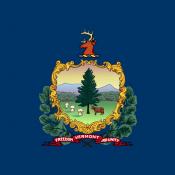
Official State Flag of Vermont
Vermont’s state flag was authorized in 1919 and features the state coat of arms (which includes the state motto) against a field of blue. All State Flags
From Vermont Statutes Online:
The Coat of Arms, Crest, Motto and Badge of the State shall be and are described as follows
(1) Coat of Arms. Green, a landscape occupying half of the shield; on the right and left, in the background, high mountains, blue; the sky, yellow. From near the base and reaching nearly to the top of the shield, arises a pine tree of the natural color and between three erect sheaves, yellow, placed diagonally on the right side and a red cow standing on the left side of the field.
(2) Motto and Badge. On a scroll beneath the shield, the motto: Vermont; Freedom and Unity. The Vermonter’s badge: two pine branches of natural color, crossed between the shield and scroll.
(3) Crest. A buck’s head, of natural color, placed on a scroll, blue and yellow.
Virginia: 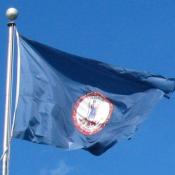 The state flag of Virginia has a deep blue field with a circle of white in the center on both sides of the flag. In this white circle Virginia’s coat of arms is painted or embroidered, as described by the convention of 1776 (also the description of Virginia’s state seal):
The state flag of Virginia has a deep blue field with a circle of white in the center on both sides of the flag. In this white circle Virginia’s coat of arms is painted or embroidered, as described by the convention of 1776 (also the description of Virginia’s state seal):
“Virtus, the genius of the commonwealth, dressed like an Amazon, resting on a spear with one hand, and holding a sword in other, and treading on tyranny, represented by a man prostrate, a crown fallen from his head, a broken chain in his left hand and a scourge in his right. In the exergon the word Virginia over the head of Virtus, and underneath the words “Sic Semper Tyrannis.”
Washington: 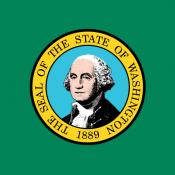 Washington’s flag is the only state flag on a field of green; an appropriate color for the evergreen state (Washington’s unofficial nickname).
Washington’s flag is the only state flag on a field of green; an appropriate color for the evergreen state (Washington’s unofficial nickname).
Washington also has the only state flag displaying an image of an actual person (George Washington, our first president). All State Flags – All State Nicknames
Legal Description of the Washington state flag:
The official flag of the state of Washington shall be of dark green silk or bunting and shall bear in its center a reproduction of the seal of the state of Washington embroidered, printed, painted or stamped thereon. The edges of the flag may, or may not, be fringed. If a fringe is used the same shall be of gold or yellow color of the same shade as the seal. The dimensions of the flag may vary.
Washington is the only state that is named in honor of a United States president.
West Virginia: 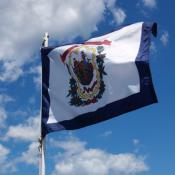 The West Virginia flag features the state motto “Montani Semper Liberi” (Latin for “Mountaineers Are Always Free”), a wreath of Rhododendron (the state flower), and the state coat-of-arms (also on the state seal).
The West Virginia flag features the state motto “Montani Semper Liberi” (Latin for “Mountaineers Are Always Free”), a wreath of Rhododendron (the state flower), and the state coat-of-arms (also on the state seal).
The official description for the state flag of West Virginia: “The proportions of the flag of the State of West Virginia shall be the same as those of the United States ensign; the field shall be pure white, upon the center of which shall be emblazoned in proper colors, the coat-of arms of the State of West Virginia upon which appears the date of the admission of the State into the Union, also with the motto, ‘Montani Semper Liberi’ (Mountaineers Are Always Free). Above the coat-of-arms of the State of West Virginia there shall be a ribbon lettered, ‘State of West Virginia,’ and arranged appropriately around the lower part of the coat-of-arms of the State of West Virginia a wreath of Rhododendron maximum in proper colors. The field of pure white shall be bordered by a strip of blue on four sides. The flag of the State of West Virginia when used for parade purposes shall be trimmed with gold colored fringe on three sides and when used on ceremonial occasions with the United States ensign, shall be trimmed and mounted in similar fashion to the United States flag as regards fringe, cord, tassels, and mounting.”
Wisconsin: 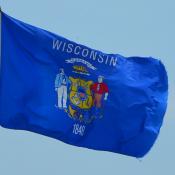 The Wisconsin state flag features the state coat of arms on both sides against a field of blue, with the the state name; “WISCONSIN” above and “1848” below (the year Wisconsin was admitted to the Union). The coat of arms, which includes the state motto, is also used on Wisconsin’s state seal.
The Wisconsin state flag features the state coat of arms on both sides against a field of blue, with the the state name; “WISCONSIN” above and “1848” below (the year Wisconsin was admitted to the Union). The coat of arms, which includes the state motto, is also used on Wisconsin’s state seal.
1860s
Originally designed in 1866 when regiments from Wisconsin wanted a flag for battlefield use, in 1913, state statutes specified the design of the state flag.
1940s
In 1941, Carl R. Eklund reported that he raised the state flag over Antarctica, at the behest of Wisconsin Governor Julius P. Heil, about 500 miles north of the south pole and 620 miles into a previously unexplored area. In 1958, Eklund flew another flag over Antarctica which he presented for display in a state museum.
1950s
In 1953, state assemblyman William N. Belter of Wautoma criticized the flag as too costly because of the details.
1970s
In 1973, when the state senate was attempting to add the word Wisconsin to the flag, it was criticized as already too cluttered.[6]
Unofficial flag using the Seal
In 1975, some state flags were being sold that improperly had the state seal on them instead of the state coat of arms. Wisconsin Secretary of State Douglas J. La Follette noted that the correct state flag did not have the banner of thirteen stars at the bottom.
1980s
In order to distinguish it from the many other blue U.S. state flags, Wisconsin’s flag was modified in 1979 to add “Wisconsin” and “1848”, the year Wisconsin was admitted to the Union.[8] All Wisconsin state flags manufactured after May 1, 1981, were required to use this design.
Wyoming : 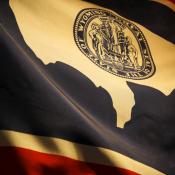 Wyoming was one of the last states to ratify an official state flag in 1917.
Wyoming was one of the last states to ratify an official state flag in 1917.
In 1916 an open competition was held by Wyoming’s DAR (Daughters of the American Revolution) for the design of an official Wyoming flag. Between 37 entries, Verna Keays won the $20 first-place prize with her design of a bison (Wyoming’s official state mammal) with the state seal branded at its center. Her design was made official by legislature in 1917.
In Verna’s original design, the bison faced away from the staff as a symbol of the freedom with which the bison had once roamed over the Wyoming plains. Dr. Grace Raymond Hebard (state regent for the DAR at the time), felt the design would be more balanced with the bison facing the staff. The first flags were printed this way, and though Wyoming legislation has not officially recognized this change, Wyoming flags have been printed with the bison facing the staff since 1917.
The red, white, and blue colors of the state flag are the same as those of the national flag. The red on the border is a symbol of the native Americans who inhabited Wyoming long before settlers came, and also represents the blood of pioneers who gave their lives to claim the soil. White is a symbol for the purity and uprightness of Wyoming. Blue is for Wyoming’s sky and mountains, and is also a symbol of fidelity, justice and virility.
The flag of the state of Wyoming consists of the silhouette of an American bison. The red symbolizes the Native Americans and the blood of pioneers who gave their lives. The white is a symbol of purity and uprightness. The blue is the color of the skies and distant mountains. It is also a symbol of fidelity, justice and virility. The bison represents the local fauna, while the seal on it symbolizes the custom of branding livestock.
See State symbols

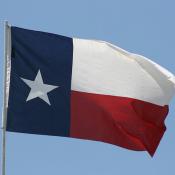 The Texas state flag is the 1839 National flag of the Republic of Texas, which features the famous Lone Star (also seen on the Texas state seal and the U.S. mint’s commemorative quarter for Texas). The red, white, and blue of the state flag of Texas represent bravery, purity and loyalty. All State Flags
The Texas state flag is the 1839 National flag of the Republic of Texas, which features the famous Lone Star (also seen on the Texas state seal and the U.S. mint’s commemorative quarter for Texas). The red, white, and blue of the state flag of Texas represent bravery, purity and loyalty. All State Flags